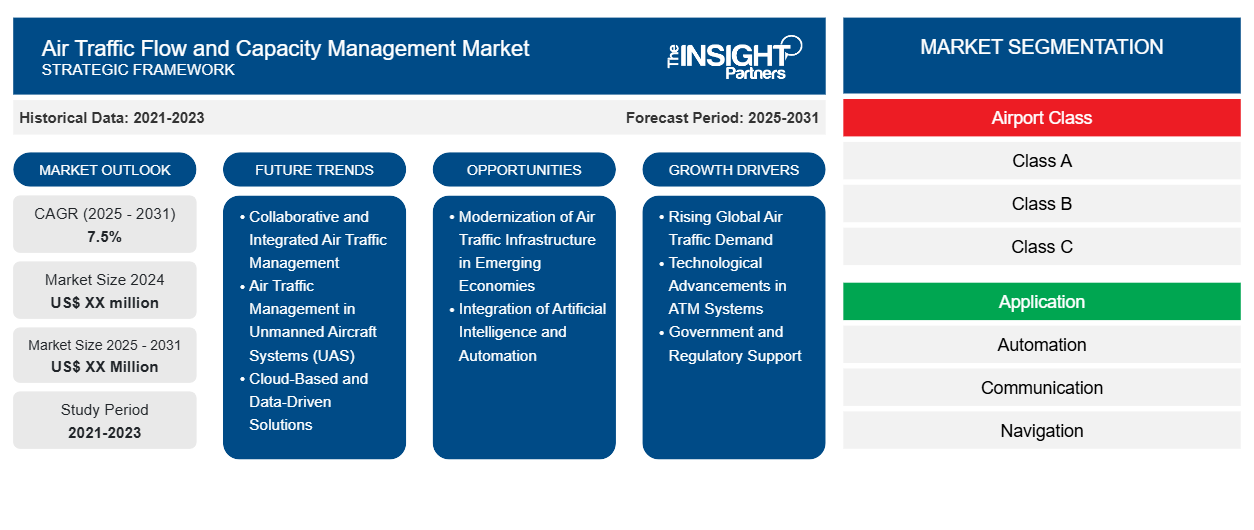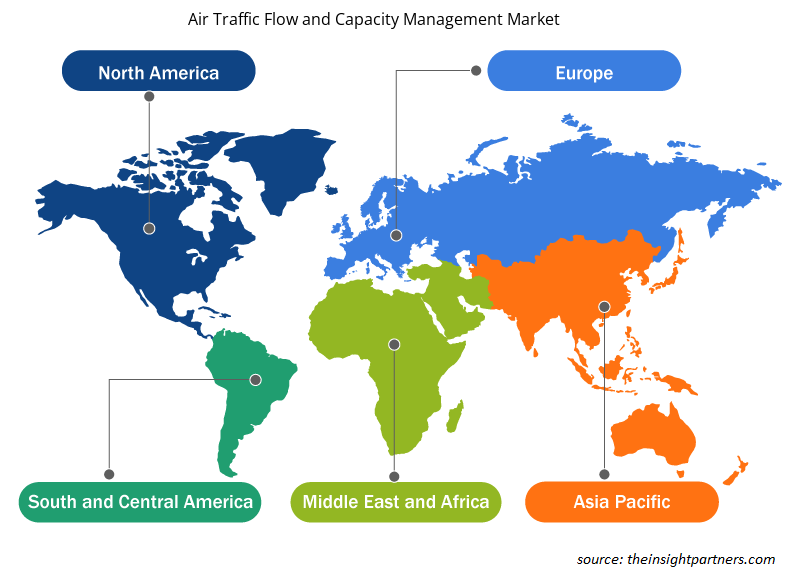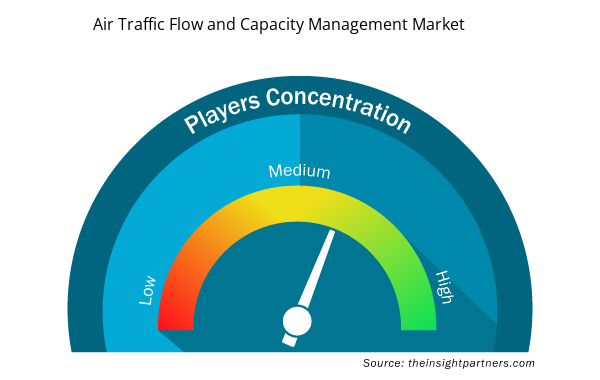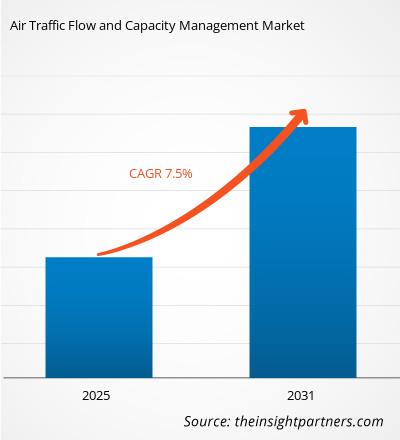The Air Traffic Flow and Capacity Management Market is expected to register a CAGR of 7.5% from 2025 to 2031, with a market size expanding from US$ XX million in 2024 to US$ XX Million by 2031.
The report is segmented by Airport Class (Class A, Class B, Class C); Application (Automation, Communication, Navigation, Simulation, Surveillance); End User (Civil and Commercial, Military and Defense). The global analysis is further broken-down at regional level and major countries. The Report Offers the Value in USD for the above analysis and segments.
Purpose of the Report
The report Air Traffic Flow and Capacity Management Market by The Insight Partners aims to describe the present landscape and future growth, top driving factors, challenges, and opportunities. This will provide insights to various business stakeholders, such as:
- Technology Providers/Manufacturers: To understand the evolving market dynamics and know the potential growth opportunities, enabling them to make informed strategic decisions.
- Investors: To conduct a comprehensive trend analysis regarding the market growth rate, market financial projections, and opportunities that exist across the value chain.
- Regulatory bodies: To regulate policies and police activities in the market with the aim of minimizing abuse, preserving investor trust and confidence, and upholding the integrity and stability of the market.
Air Traffic Flow and Capacity Management Market Segmentation
Airport Class
- Class A
- Class B
- Class C
Application
- Automation
- Communication
- Navigation
- Simulation
- Surveillance
End User
- Civil and Commercial
- Military and Defense
Geography
- North America
- Europe
- Asia-Pacific
- South and Central America
- Middle East and Africa
Customize This Report To Suit Your Requirement
You will get customization on any report - free of charge - including parts of this report, or country-level analysis, Excel Data pack, as well as avail great offers and discounts for start-ups & universities
Air Traffic Flow and Capacity Management Market: Strategic Insights

- Get Top Key Market Trends of this report.This FREE sample will include data analysis, ranging from market trends to estimates and forecasts.
Air Traffic Flow and Capacity Management Market Growth Drivers
- Rising Global Air Traffic Demand: The continued growth of global air traffic, driven by increasing passenger numbers and cargo demand, is a major driver of the air traffic flow and capacity management market. As air travel recovers from the pandemic and expands, airports and air navigation service providers (ANSPs) must optimize airspace and airport capacity to manage this influx. To accommodate this growth while maintaining safety and efficiency, advanced systems for air traffic management (ATM) are required to ensure smooth and effective operations. The rise in air traffic puts pressure on existing infrastructure, necessitating improvements in flow management to avoid congestion and delays.
- Technological Advancements in ATM Systems: Technological innovations, including the adoption of artificial intelligence (AI), machine learning (ML), automation, and advanced data analytics, are transforming air traffic management systems. These advancements enable real-time optimization of air traffic flow, better prediction of congestion points, and more efficient use of available capacity. Automation in air traffic control towers and advanced flight management systems reduce human error and increase operational efficiency, driving the need for upgraded solutions in air traffic flow and capacity management.
- Government and Regulatory Support: Governments and regulatory bodies across the globe are increasingly prioritizing the modernization of air traffic management systems to enhance safety, reduce delays, and improve environmental efficiency. Regulatory initiatives, such as the Single European Sky (SES) in Europe, are pushing for collaborative and integrated management of airspace, which drives investments in air traffic flow management solutions. Additionally, governments are incentivizing the development of more efficient ATM systems to meet sustainability targets, reducing carbon emissions by optimizing flight paths and airspace use
Air Traffic Flow and Capacity Management Market Future Trends
- Collaborative and Integrated Air Traffic Management: A key trend in the air traffic flow and capacity management market is the shift towards collaborative and integrated air traffic management systems. Initiatives like the SESAR (Single European Sky ATM Research) in Europe and NextGen in the U.S. aim to create a seamless and unified air traffic control infrastructure across regions. This collaboration enables better coordination between air traffic controllers, airlines, and airports, improving the flow of air traffic across national boundaries. Integrated systems facilitate real-time data sharing and enhance decision-making, helping to manage capacity constraints and reduce delays.
- Air Traffic Management in Unmanned Aircraft Systems (UAS): The rise of drones and unmanned aircraft systems (UAS) is another emerging trend that is reshaping air traffic flow management. UAS traffic management (UTM) is becoming an essential aspect of the air traffic management market as these systems require dedicated infrastructure for safe integration with manned flights. Governments and regulatory bodies are developing UTM frameworks to ensure the safe, efficient operation of drones in congested airspace. As the commercial use of drones expands, UTM will become a critical part of managing overall air traffic capacity, creating a trend towards the inclusion of drone management in traditional ATM systems.
- Cloud-Based and Data-Driven Solutions: Air traffic flow and capacity management systems are increasingly adopting cloud-based technologies and data-driven solutions. These systems offer significant advantages, including enhanced scalability, real-time data access, and cost-effective deployment. Cloud-based systems allow for the centralization of air traffic management operations, enabling easier coordination between multiple stakeholders, including airports, airlines, and air navigation service providers. Data analytics play a key role in optimizing air traffic, predicting congestion points, and improving decision-making through the analysis of historical and real-time flight data. These technologies are crucial in enabling more responsive and flexible air traffic management solutions
Air Traffic Flow and Capacity Management Market Opportunities
- Modernization of Air Traffic Infrastructure in Emerging Economies: Emerging economies, particularly in Asia-Pacific, Africa, and Latin America, are investing heavily in the modernization of their air traffic management infrastructure. As air traffic increases in these regions, there is a strong opportunity to implement new and advanced air traffic flow and capacity management systems. These regions are looking to enhance airport capacity, improve safety, and optimize airspace use through modern ATM technologies. Companies that offer cutting-edge solutions for air traffic management can capitalize on these growing markets by providing scalable, cost-effective systems that meet the demands of expanding aviation industries.
- Integration of Artificial Intelligence and Automation: The integration of AI, machine learning, and automation in air traffic flow management offers significant opportunities to enhance operational efficiency. AI can analyze vast amounts of flight data to predict traffic patterns, optimize flight paths, and manage congestion in real-time. Automation in air traffic control can reduce human error and increase throughput, enabling smoother operations even in high-traffic conditions. Companies that invest in developing AI-powered air traffic management solutions stand to gain a competitive edge in a market increasingly driven by technological innovation.
Air Traffic Flow and Capacity Management Market Regional Insights
The regional trends and factors influencing the Air Traffic Flow and Capacity Management Market throughout the forecast period have been thoroughly explained by the analysts at Insight Partners. This section also discusses Air Traffic Flow and Capacity Management Market segments and geography across North America, Europe, Asia Pacific, Middle East and Africa, and South and Central America.

- Get the Regional Specific Data for Air Traffic Flow and Capacity Management Market
Air Traffic Flow and Capacity Management Market Report Scope
| Report Attribute | Details |
|---|---|
| Market size in 2024 | US$ XX million |
| Market Size by 2031 | US$ XX Million |
| Global CAGR (2025 - 2031) | 7.5% |
| Historical Data | 2021-2023 |
| Forecast period | 2025-2031 |
| Segments Covered |
By Airport Class
|
| Regions and Countries Covered | North America
|
| Market leaders and key company profiles |
Air Traffic Flow and Capacity Management Market Players Density: Understanding Its Impact on Business Dynamics
The Air Traffic Flow and Capacity Management Market market is growing rapidly, driven by increasing end-user demand due to factors such as evolving consumer preferences, technological advancements, and greater awareness of the product's benefits. As demand rises, businesses are expanding their offerings, innovating to meet consumer needs, and capitalizing on emerging trends, which further fuels market growth.
Market players density refers to the distribution of firms or companies operating within a particular market or industry. It indicates how many competitors (market players) are present in a given market space relative to its size or total market value.
Major Companies operating in the Air Traffic Flow and Capacity Management Market are:
- ALTYS Technologies
- BAE Systems
- Frequentis
- ENAIRE
- L3Harris Technologies, Inc.
Disclaimer: The companies listed above are not ranked in any particular order.

- Get the Air Traffic Flow and Capacity Management Market top key players overview
Key Selling Points
- Comprehensive Coverage: The report comprehensively covers the analysis of products, services, types, and end users of the Air Traffic Flow and Capacity Management Market, providing a holistic landscape.
- Expert Analysis: The report is compiled based on the in-depth understanding of industry experts and analysts.
- Up-to-date Information: The report assures business relevance due to its coverage of recent information and data trends.
- Customization Options: This report can be customized to cater to specific client requirements and suit the business strategies aptly.
The research report on the Air Traffic Flow and Capacity Management Market can, therefore, help spearhead the trail of decoding and understanding the industry scenario and growth prospects. Although there can be a few valid concerns, the overall benefits of this report tend to outweigh the disadvantages.
- Historical Analysis (2 Years), Base Year, Forecast (7 Years) with CAGR
- PEST and SWOT Analysis
- Market Size Value / Volume - Global, Regional, Country
- Industry and Competitive Landscape
- Excel Dataset



Report Coverage
Revenue forecast, Company Analysis, Industry landscape, Growth factors, and Trends

Segment Covered
This text is related
to segments covered.

Regional Scope
North America, Europe, Asia Pacific, Middle East & Africa, South & Central America

Country Scope
This text is related
to country scope.
Frequently Asked Questions
Some of the customization options available based on the request are an additional 3-5 company profiles and country-specific analysis of 3-5 countries of your choice. Customizations are to be requested/discussed before making final order confirmation, as our team would review the same and check the feasibility.
The report can be delivered in PDF/PPT format; we can also share excel dataset based on the request.
The leading players operating in the Air Traffic Flow and Capacity Management Market include ALTYS Technologies, BAE Systems, Frequentis, ENAIRE, L3Harris Technologies, Inc., Honeywell International Inc., Intelcan Technosystems Inc., Leonardo S.p.A., Metron Aviation, Inc.
The Air Traffic Flow and Capacity Management Market is estimated to witness a CAGR of 7.5% from 2023 to 2031
Focus on Automation and Emphasis on Sustainability is the key future trend of the Air Traffic Flow and Capacity Management Market
The major factors driving the Air Traffic Flow and Capacity Management Market are: Increasing Air Travel and Advancements in Technology
Trends and growth analysis reports related to Aerospace and Defense : READ MORE..
1. ALTYS Technologies
2. BAE Systems
3. Frequentis
4. ENAIRE
5. L3Harris Technologies, Inc.
6. Honeywell International Inc.
7. Indra
8. Intelcan Technosystems Inc.
9. Leonardo S.p.A.
10. Metron Aviation, Inc.

 Get Free Sample For
Get Free Sample For